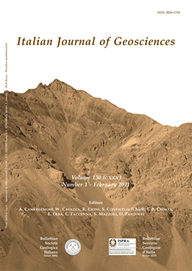
FRONTIERS - Intrusion of Mafic magmas Into Felsic Magma Chambers: New Insights from Natural Outcrops and Fluid-Mechanics Experiments
Diego Perugini(*) & Giampiero Poli(*)
(*) Department of Earth Sciences, University of Perugia, Piazza Università - 06100 Perugia, Italy. Tel.: (+39) 0755852610; Fax: (+39) 0755852603; E-mail: diegop@unipg.it
Volume: 130 (2011) f.1
Pages: 3-15
Abstract
The injection of mafic magmas into felsic magmas is studied focussing on three natural case studies in which the process was frozen at the initial stages. The contact morphology between magmas is strongly variable in each outcrop and has been quantified by the fractal dimension.
Natural morphologies are identical to those produced in the «viscous-fingering» process where a low viscosity fluid displaces a high viscosity one. Viscous-fingering fluid-mechanics experiments have been performed using fluids with different viscosity ratios. A very good empirical exponential relationship has been found between fractal dimension of experimental structures and viscosity ratio.
Using the empirical relationship derived from experiments, and using the values of fractal dimension measured on natural samples, the viscosity ratios between magmas has been estimated. Results indicated that magmas with highly variable viscosity ratios coexisted in each studied magmatic system. These results have been explained hypothesizing the heating of the felsic magma by continuous inputs of the high temperature mafic magma. Such a process may explain and physically justify a decrease of viscosity contrasts between magmas as the injection of the mafic magma proceeds in time.
Results from this study may give new insights into the potential evolution of magma mixing processes in plutonic environments. In fact, it is suggested that the viscous fingering may be a very important process contributing to drifting the viscosity ratio between magmas towards low values and, hence, towards the best rheological conditions to trigger widespread mixing processes in the magma chamber.
We show that combining fractal geometry measurements on natural rocks and fluid-mechanics experiments may help to shed new light into geological processes whose knowledge may open new frontiers in the study of igneous systems and their evolution in time and space.
Keywords
Get Full Text